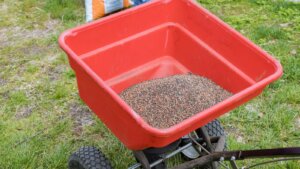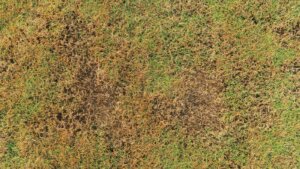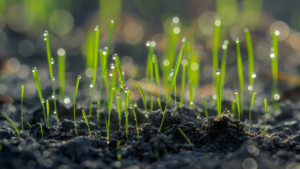What is Humic Acid?
Farmers, soil scientists and hard core gardeners are familiar with this incredible earth friendly product, but, humic and fulvic acids are not typically household words. These organic products are becoming the future of home gardening.
Going back as far as the prehistoric ages, plants have been harvesting carbon dioxide from the atmosphere. It uses the sun’s energy to build plant biomass in order to feed insects and vertebrates. A cycle begins as plants and animals give carbon back, eventually becoming soil organic matter.
Humic acid is a naturally occurring organic compound that is found in soil, peat, coal, and other sedimentary deposits. It is composed of a complex mixture of organic acids, including fulvic acid and humic acid, which are important for soil health and plant growth. Humic acid helps to improve soil structure and fertility by increasing the availability of essential nutrients, such as nitrogen and phosphorus, to plants. It improves water retention in soil, making it more drought-resistant. Humic acid is also used in agriculture as a soil accompaniment and fertilizer to improve the quality of crops. It is also used in water treatment, to remove pollutants and heavy metals from drinking water.
Humic acid is a complex molecule. It is a natural element which is also found in oceans and freshwater. When plants and animals break down, a group of chemicals are formed called fulvic acid. Humic and fulvic acids are the natural decay of plants and animals. It is interesting that the components we use in our gardens today are what is found in prehistoric deposits. Layers of sedimentation are one source of humic acid which originated deep within the earth’s crust. Throughout the years, these layers have been resurrected close to the surface. High concentrations of humic acid are found in these layers.
What Does Humic Acid Do For Lawns?
Applying humic acid to your lawn has many plant health benefits. It increases the water retention capacity of the soil as well as nutrient holding capacity in the soil. This translates to more nutrients for your turf. Humic acid increases soil carbon and the soil’s water holding capacity. It also unlocks nutrients. Humic acid will arouse microbes which will benefit the soil and improve nutrient exchange between the plant and the soil.
Humic acids are organic and a great way to deliver a concentrated dose of vitamins, essential nutrients and trace elements to plants and soil. Adding organic substances like humic acid will enhance plant growth and soil fertility.
Humic acid can be a great addition to your lawn care routine. It can help improve the overall health of your lawn by increasing the availability of nutrients and promoting stronger root growth. By improving soil structure, it can also help to retain moisture and reduce the amount of water needed for your lawn. Additionally, it can help to balance the pH of your soil, making it more neutral and easier for your grass to absorb nutrients.
Would you like a lawn that is resistant to disease and pests? Humic acid can help to improve the overall immunity of your lawn, making it more resistant to such annoyances. It can also be a natural alternative to chemical fertilizers, providing a safe and environmentally-friendly option for your lawn care giving peace of mind for your family and your pets. Additionally, it can improve the color and appearance of your lawn by promoting healthy growth and making it greener and thicker. Overall, humic acid can be a great addition to your lawn care routine, helping to improve soil health, promote strong root growth and making your lawn more resistant to disease and pests.
The Importance of Using Humic and Fulvic Acids
Humic and fulvic acids are critical to plant health. It helps in the transfer of nutrients from the soil to the plant. Plant health will benefit and stronger plants with better absorption will happen with this complex mixture.
There are a number of key differences between humic acid and fulvic acids. Humic acids are larger than fulvic acids when looked at in its molecular form. Humic acid performs better in alkaline soils. Fulvic acid performs in both alkaline and acidic soils. Both organic acids are very similar and one or the other will meet your requirements without purchasing both. Some products have both humic and fulvic acids combined. Be sure that when you purchase the product that both humic and fulvic are listed on the label.
The role that fulvic acid plays in plant health is the transferring of nutrients from the soil to the plant. Humic and fulvic acids come in many qualities. Better qualities will maximize benefits.
Humic and fulvic acids play a big role in plant health. It has the ability to transfer the nutrients from the soil to the plant.
Fulvic acid is used in multiple ways to improve plant health. Add it to soil to improve nutrient uptake, spray it on foliage to prevent disease or apply to roots to stimulate growth. These simple rules will improve the plants health.
Ecological benefits of humic acids are diverse. Environmental issues are important and humic acid offers effective solutions to the preservation of the environment.
Why Should You Add Humic Acid To Your Soil?
Humic acid is an important component for your soil. It improves soil structure, prevents nutrient losses and encourages decomposition of sandy soils. Humic acid can also prevent problems like soil cracking, soil erosion and surface water runoff.
Soil workability is easier when using humic acid. It helps soil loosen and crumble and increase soil aeration. This prevents drought due to increased water holding capacity. The color of the soil becomes darker and helps with the absorption of the sun’s energy.
Fixation properties in soils are chemically changed with the use of humic acids. The pH levels become regulated, acidic and alkaline soils are neutralized and richness in organic and mineral substances that are important for the growth cycle of the plant are increased. Minerals which are important to a plant’s growth are aided through the use of humic acids. The use of humic substances promotes the retention of soluble inorganic fertilizers in the root zones and reduces leaching. Humic substances also help to convert nutrient elements like nitrogen, phosphorus, potassium, + iron, zinc and other trace elements. The benefits of humic acids never end. It enhances the uptake of nitrogen by plants, mineral fertilizers increases productivity and reduces toxic substances in soil.
Is Humic Acid and Fulvic Acid The Same?
Humic acid and fulvic acid are both naturally occurring substances that are derived from decaying plant matter, but they are not the same. Both have similar properties and benefits, but they are chemically and structurally different. Humic acid is the most complex and largest molecule of the humic substances, it is typically found in soil, water and compost. It’s known for its ability to improve soil structure and increase the availability of nutrients to plants. Fulvic acid is a smaller molecule than humic acid and is typically found in humic acids. It’s known for its ability to improve nutrient absorption and transport, as well as its ability to neutralize toxins and free radicals. Humic acid and fulvic acid can be used together for their combined benefits, as they have different properties that complement each other. Some companies sell them combined as a product while others sell them separately. It’s important to note that the terms “humic acid” and “fulvic acid” are often used interchangeably in the industry, but they are not the same thing. They should be understood as different substances with different properties and uses.
Knowing the small differences between humic acid and fulvic acids can help you better understand the choices available. Humic acids are larger than fulvic acids when looked at in its molecular form. Humic acid performs better in alkaline soils. Fulvic acid performs in both alkaline and acidic soils. Both organic acids are very similar and one or the other will meet your requirements without purchasing both. Be sure that when you purchase the product that both humic and fulvic are listed on the label if you intend to use the combination.



